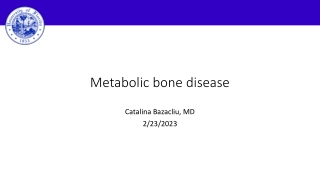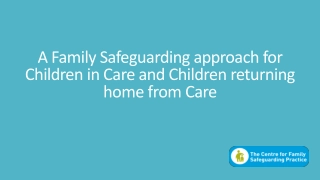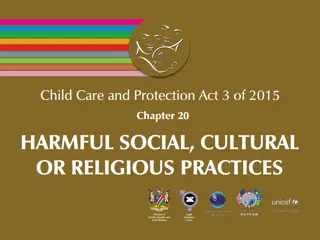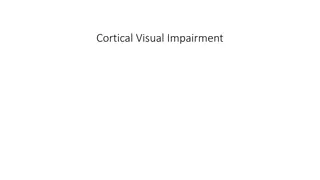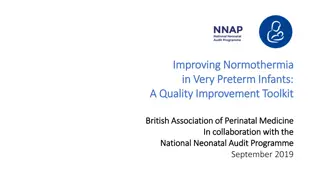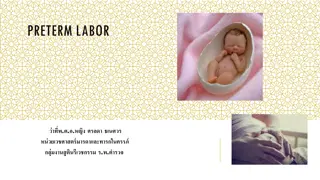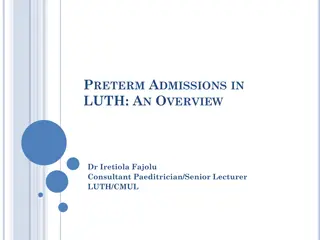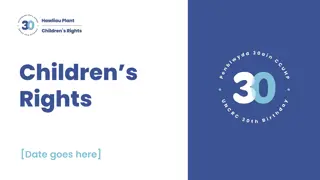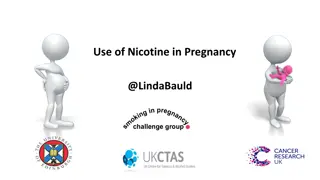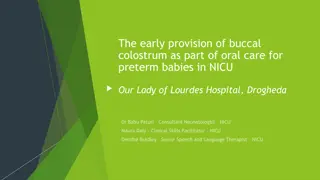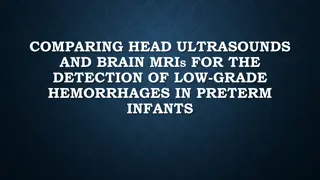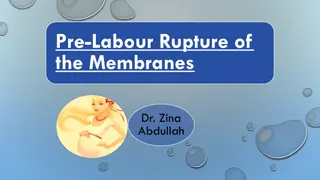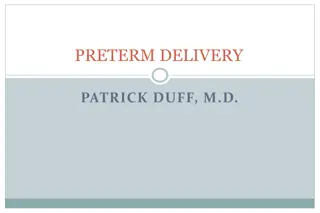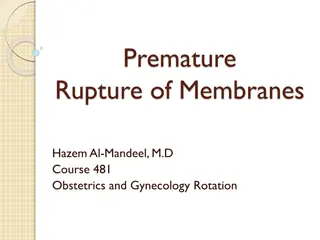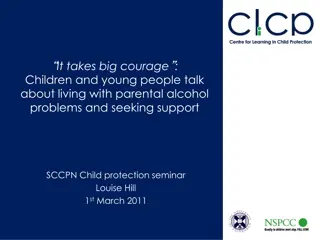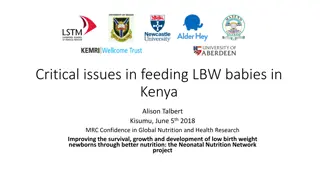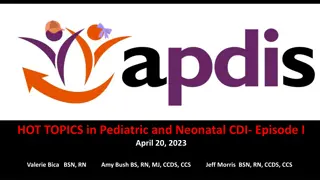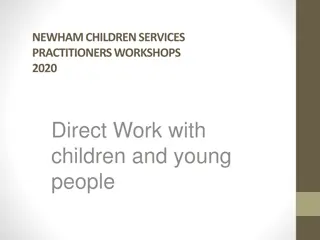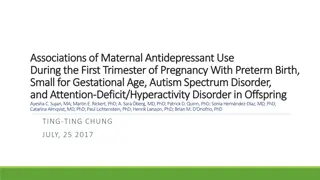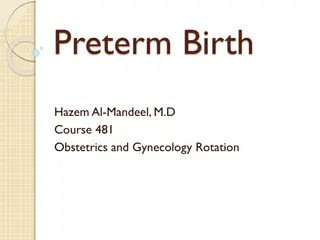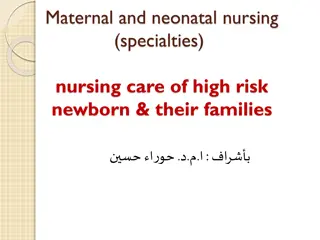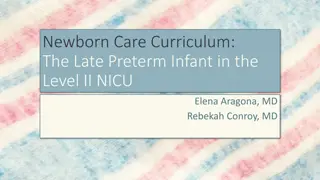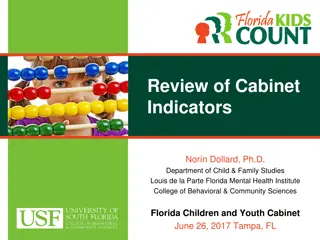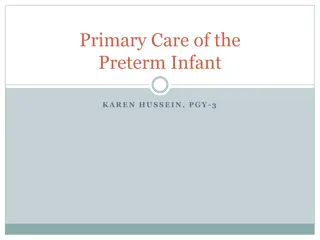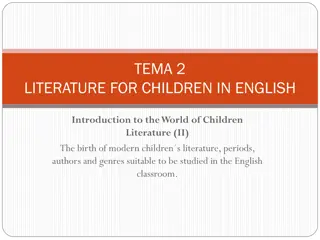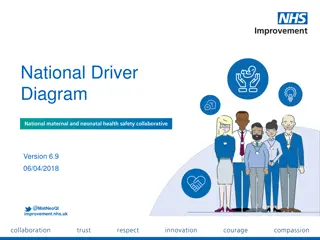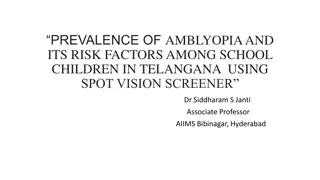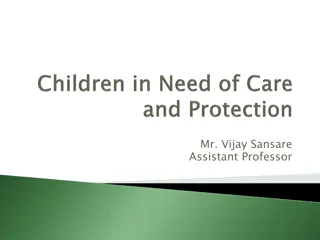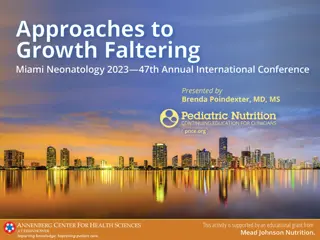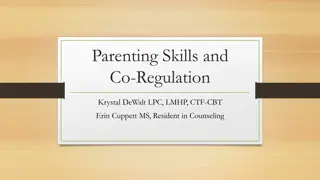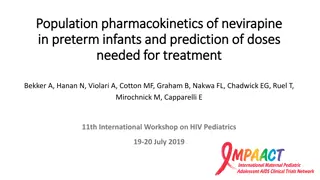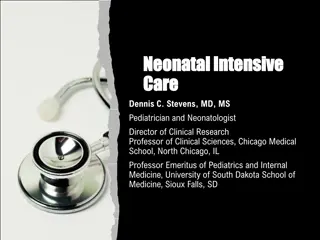Metabolic bone disease
Understand the metabolism of calcium and phosphorus, common disturbances, and nutrient requirements in preterm infants. Learn why metabolic bone disease is important and its long-term effects on bone health.
1 views • 59 slides
A Family Safeguarding Approach for Children in Care
Families often come into contact with children's social care due to parenting under adversarial conditions rather than causing harm. The need for a change in vision and values underpinning family safeguarding duties is crucial, emphasizing the importance of helping families raise their children. Lad
1 views • 25 slides
Early Intervention Approaches and Research Findings
Explore various approaches and techniques for early intervention, focusing on settings, delivery models, stimulation methods, and caregiver involvement. Discover recent studies on infants born during the pandemic and preterm children's outcomes, emphasizing the importance of language, motor, and cog
1 views • 67 slides
Understanding the Power of Praise in Child Development
Praise plays a crucial role in promoting children’s self-esteem and overall development. By offering genuine praise for being and doing, parents can nurture a positive sense of self-worth in their children. Research shows that praised children tend to excel academically, show resilience, and lead
0 views • 26 slides
Challenges in Safeguarding Children: Herefordshire Inspection Report
The briefing highlights concerning findings from the inspection of Herefordshire children's services, revealing significant weaknesses in social work practice, poor assessments, and insufficient plans to ensure children's safety and well-being. The report identifies systemic issues such as drift, de
0 views • 27 slides
Safeguarding Children: Legislation Against Harmful Practices
The Child Care and Protection Act of 2015, Chapter 20, addresses harmful social, cultural, and religious practices affecting children in Namibia. The Act prohibits practices detrimental to children's well-being, such as child marriage, and imposes penalties on those who subject children to such prac
0 views • 14 slides
Understanding Cortical Visual Impairment in Infants
Cortical Visual Impairment (CVI) is a condition resulting from retrogeniculate brain damage that affects visual processing in infants. Commonly observed in premature infants, CVI can manifest as atypical behaviors like staring at lights, optic atrophy, and nystagmus. The causes range from structural
2 views • 23 slides
Quality Improvement Toolkit for Improving Normothermia in Very Preterm Infants
This resource provides a comprehensive toolkit developed by the British Association of Perinatal Medicine in collaboration with the National Neonatal Audit Programme to assist clinicians in neonatal units in delivering normothermia to very preterm infants. It includes evidence-based interventions, d
1 views • 17 slides
Understanding Preterm Labor and Its Impact on Infant Health
Preterm labor, defined as the delivery of an infant before 37 weeks of gestation, presents risks such as incomplete organ system development and increased infant mortality rates. Unnecessary obstetrical interventions before 38-39 weeks should be avoided. The trends in preterm birth rates reveal disp
0 views • 68 slides
Anesthetic Considerations for Necrotizing Enterocolitis in Neonates
Necrotizing enterocolitis (NEC) is a serious gastrointestinal emergency in neonates, especially those with very low birth weight. Mortality rates are high, and early diagnosis is crucial. Key features, pathophysiology, implications for anesthetic preparation, and diagnostic considerations are discus
3 views • 20 slides
Neonatal Care at Lagos University Teaching Hospital (LUTH)
Lagos University Teaching Hospital (LUTH) is a tertiary referral center providing comprehensive neonatal care services. The facility has specialized units for inborn and outborn babies, offering advanced medical care, including neonatologists, resident doctors, nurses, and support staff. LUTH also h
0 views • 15 slides
Understanding Children's Rights and the Role of the Children's Commissioner for Wales
Children and young people up to 18 years are entitled to rights under the United Nations Convention of the Rights of the Child (UNCRC). This agreement aims to protect children and ensure they are happy, healthy, and safe. It covers topics such as the role of the Children's Commissioner for Wales, Sa
3 views • 10 slides
Impact of Nicotine Use in Pregnancy: Risks and Consequences
Smoking and nicotine use during pregnancy pose significant risks, including low birth weight, stillbirth, miscarriage, preterm birth, heart defects, and Sudden Infant Death Syndrome. Nicotine Replacement Therapy is licensed for pregnant women but lacks evidence of effectiveness in smoking cessation
1 views • 23 slides
Improving Buccal Colostrum Provision for Preterm Babies in NICU
Early administration of buccal colostrum to preterm babies in the NICU has shown positive outcomes such as improved gut development, reduced infection rates, and enhanced breastfeeding rates. A Quality Improvement program at Our Lady of Lourdes Hospital aimed to provide buccal colostrum within 6 hou
1 views • 5 slides
Detection of Low-Grade Hemorrhages in Preterm Infants: Ultrasounds vs. MRIs
This study compares the effectiveness of head ultrasounds and brain MRIs in detecting low-grade hemorrhages in preterm infants. It discusses the incidence of intraventricular hemorrhage (IVH) in very low birth weight infants, classification of IVH, risk factors for IVH, outcomes related to IVH grade
9 views • 33 slides
Clinical Diagnosis and Assessment of Pre-Labour Rupture of the Membranes
Pre-Labour Rupture of the Membranes (RROM) is characterized by the leakage of amniotic fluid before the onset of labor, particularly when the gestational age is less than 37 weeks. Clinical diagnosis involves a thorough history evaluation and examination, including sterile speculum examination to co
0 views • 18 slides
Understanding Preterm Delivery: Causes, Complications, and Evaluation
Preterm delivery, defined as labor prior to 37 weeks of gestation, affects approximately 12% of pregnancies worldwide, with almost 30% of these deliveries occurring before 34 weeks. The etiology of preterm birth can vary from maternal factors such as PROM to fetal anomalies and multiple gestations.
0 views • 25 slides
Premature Rupture of Membranes: Diagnosis and Management Overview
Premature rupture of membranes (PROM) is a complication in pregnancy where the amniotic sac breaks before labor begins. Risk factors include infections and multiple gestations. Diagnosis involves history, physical examinations, and tests like nitrazine and ferning tests. Management depends on gestat
0 views • 7 slides
Understanding Cesarean Section and Preterm Labor Risks
Cesarean section (C/S) is a delivery method for various fetal and maternal indications, while preterm labor poses risks like twin pregnancy, uterine abnormalities, and infections. Complications of C-sections and signs of preterm labor are discussed, highlighting the importance of early recognition a
0 views • 9 slides
Understanding Maternal Mental Health Complications
Maternal mental health complications, including postpartum depression and psychosis, can have a significant impact on both the mother and child's well-being. Factors such as stigma, culture, trauma, and lack of support systems can exacerbate these conditions. Early detection and intervention are cru
0 views • 12 slides
Overview of Induction of Labour for Obstetric Practice
Induction of labor is the artificial initiation of the labor process before it begins naturally. This procedure is performed in cases such as premature rupture of membranes, prolonged pregnancy, preterm premature rupture of membranes, pre-eclampsia, and maternal medical conditions like diabetes or c
1 views • 30 slides
Understanding the Impact of Parental Alcohol Problems on Children
Children living with parental alcohol problems often face challenges that can have lasting effects on their well-being. This seminar highlights the need for support and courage for these children and discusses the implications for practitioners. It also sheds light on the hidden population of childr
0 views • 14 slides
Challenges in Feeding Low Birth Weight Babies in Kenya
Addressing critical issues in feeding low birth weight babies in Kenya, including the lack of accurate birth weight measurements, preterm birth rates, and the risks associated with formula milk feeding. Strategies such as promoting expressed breastmilk and supporting mothers in neonatal units are di
2 views • 15 slides
Understanding the Coding Guidelines for Preterm Newborns with Small for Gestational Age (SGA)
Explore the guidelines for coding preterm newborns who are small for gestational age, including birth weight considerations and criteria for assigning appropriate ICD-10 codes. Gain insights into differentiating SGA from low birth weight and effectively documenting neonatal cases.
0 views • 17 slides
Direct Work Strategies for Children and Young People: Newham Children Services Practitioners Workshop 2020
Explore the fundamentals of direct work with children and young people in the Newham Children Services Practitioners Workshop 2020. Discover the purpose, planning, and application of direct work, focusing on outcomes and challenges. Learn to apply a systemic and restorative approach, utilizing solut
0 views • 18 slides
Associations of Maternal Antidepressant Use During Pregnancy with Offspring Outcomes
Prenatal antidepressant exposure during the first trimester of pregnancy is linked to various adverse outcomes in offspring, including preterm birth, small for gestational age, autism spectrum disorder, and attention-deficit/hyperactivity disorder. This study evaluates the associations and alternati
0 views • 28 slides
Efficient Baby Screening and Referral Process Overview
Detailed overview of the screening process from sample collection to clinician consultation, including timelines, referral pathways, and confirmation procedures for preterm babies. Lab turnaround times, repeat sample guidelines, and referral process details are also covered.
0 views • 19 slides
Understanding Preterm Birth: Causes, Diagnosis, and Management
Preterm birth, occurring before 37 weeks of gestation, is a significant concern in obstetrics due to its association with perinatal mortality and morbidity. This article delves into the definition, incidence, etiology, risk factors, diagnosis, and management of preterm labor, providing insights on a
0 views • 8 slides
High-Risk Newborn Nursing Care and Factors
Maternal and neonatal nursing specialties focus on providing care for high-risk newborns and their families, who face conditions endangering the neonate's survival. Factors contributing to high-risk newborns include high-risk pregnancies, maternal medical illnesses like diabetes, labor complications
0 views • 25 slides
Newborn Care Curriculum for Late Preterm Infants in Level II NICU
This curriculum module focuses on the care of late preterm infants in Level II NICU settings, covering topics such as respiratory management, feeding difficulties, hypoglycemia, hypothermia, sepsis, hyperbilirubinemia, and discharge planning. It includes learning objectives, nursery care levels, phy
1 views • 42 slides
Review of Children and Youth Cabinet Indicators in Florida
The Children and Youth Cabinet in Florida adopted six key measures as benchmarks in 2017. These indicators cover areas such as low birthweight babies, children not in school readiness programs, children living in poverty, infants and toddlers without health insurance, and children under 12 at first
0 views • 10 slides
Comprehensive Primary Care Guidelines for NICU Graduates
This guide outlines the essential aspects of primary care for preterm infants discharged from the NICU. It covers key topics such as initial visit assessments, follow-up visits, screening protocols, and ongoing management strategies. Emphasis is placed on continuity of care, monitoring growth, addre
0 views • 47 slides
Evolution of Children's Literature in English: From Alice to Modern Times
Explore the birth of modern children's literature starting with the publication of "Alice's Adventures in Wonderland" in 1865 by Charles Dodgson (Lewis Carrol), marking a shift towards entertaining and engaging literature specifically for children. Prior to this, children mainly read folklore and ad
0 views • 35 slides
Enhancing Maternal and Neonatal Healthcare Improvements
This initiative aims to improve the safety and outcomes of maternal and neonatal care in England by reducing unwarranted variations, providing high-quality healthcare experiences, and enhancing systems and processes for better care. Key focuses include promoting smoke-free pregnancies, optimizing ca
0 views • 7 slides
Prevalence of Amblyopia and Risk Factors Among School Children in Telangana
The study aims to determine the prevalence of amblyopia and its risk factors among school children in rural areas of Telangana using spot vision screener. A sample of 369 children aged 5-10 years was screened, with 84 children showing amblyogenic risk factors. Out of these, 65 children were diagnose
0 views • 7 slides
Understanding Vulnerability in Children: Factors and Categories
Children are vulnerable to exploitation, abuse, and neglect due to various factors such as age, disabilities, behaviors, and powerlessness. The vulnerability of children is compounded by factors like illness, defenselessness, and passivity. Categories such as protection and children in conflict with
0 views • 17 slides
Neonatal Nutrition: Growth, Nutritional Support, and Management Phases
Neonatal nutrition, specifically focusing on growth faltering and early nutritional support, is crucial for the well-being of premature infants. Understanding growth rates and providing appropriate nutrients are key goals. Target growth rates and reference growth curves are important considerations.
0 views • 28 slides
Understanding the Impact of Trauma on Children
Trauma can significantly affect children's emotional, behavioral, and developmental well-being. Research shows that a high number of children experience traumatic events, leading to various challenges. Younger children are particularly vulnerable to the effects of trauma, depending on how their pare
0 views • 45 slides
Population Pharmacokinetics of Nevirapine in Preterm Infants
Population pharmacokinetics of nevirapine in preterm infants were evaluated to predict the doses needed for treatment. Early antiretroviral treatment recommendations for neonates, challenges with available ARV formulations, and the importance of data to inform nevirapine dosing in preterm infants we
1 views • 17 slides
Neonatal Intensive Care Overview by Dr. Dennis C. Stevens, MD
Neonatal Intensive Care (NICU) involves specialized care for preterm and full-term newborn infants with various medical conditions, requiring a multidisciplinary approach. Dr. Dennis C. Stevens, a renowned Pediatrician and Neonatologist, highlights the challenges and importance of NICU care, emphasi
0 views • 22 slides
